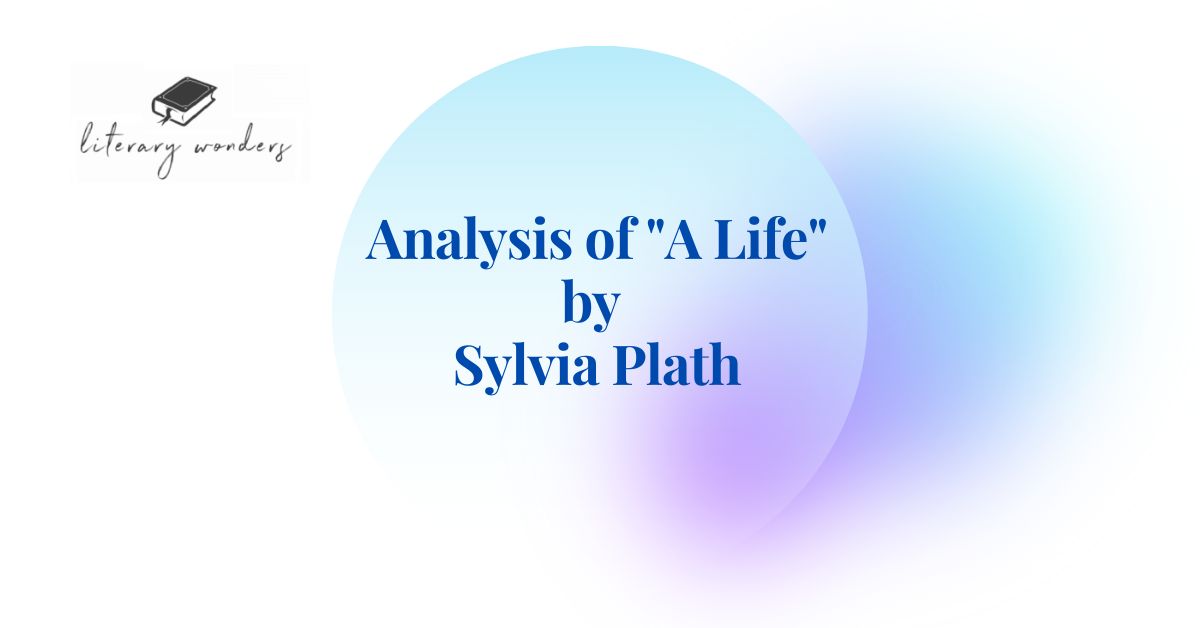Summary of “A Life” by Sylvia Plath
Written by an iconic writer and poet, Sylvia Plath’s “A Life” is a symbolic poetic piece. The poem explores the idea of existence and how it is perceived. It begins with an image of an egg-shaped bailiwick, described as clear as a tear. This image is used to symbolize the fragility and fleeting nature of life. As the poem continues, the speaker describes the inhabitants of this bailiwick as light as cork and permanently busy, suggesting that they are not truly living but instead just going through the motions of life.
The next section of the poem describes the sea waves bowing in single file and the clouds sitting tasseled and fancy like Victorian cushions. The imagery in this section creates a sense of peacefulness and serenity, which contrasts with the description of the inhabitants of the bailiwick.
The speaker then goes on to describe a woman who is dragging her shadow in a circle around a bald hospital saucer. This image symbolizes the isolation and loneliness of the woman, who is described as living quietly with no attachments, like a fetus in a bottle.
The poem’s final section describes the future as a grey seagull tattling in its cat voice of departure. The powerful description in the final part of the poem suggests that the future is uncertain and that there is a sense of impending doom.
The speaker also describes age and terror, like nurses attending the woman and a drowned man complaining of the great cold, crawling out of the sea. These vivid images are used to suggest that death is inevitable and that it will come for us all.
To read the full poem, please click here.
Major Themes in “A Life” by Sylvia Plath
The fragility of life, death, and bitter realities of life are the poem’s central themes. Throughout the poem, Plath uses impressive diction and imagery to highlight the delicate nature of life. The inhabitants of this “bailiwick” are described as “light as cork” and “permanently busy,” suggesting that life is ephemeral and we are all just passing through.
Furthermore, the description of the sea waves bowing in single file and the clouds sitting like “Victorian cushions” suggests that life is like a tapestry, a beautiful and intricate work of art constantly changing.
The description of the woman in the poem, who is described as dragging her shadow in a circle around a bald hospital saucer, represents the idea that life can be isolating and lonely. She is described as having “no attachments,” and her world is “flattened to a picture.” This suggests that life can be reduced to a mere image and that the woman is disconnected from the world around her.
The poem’s final lines highlight the idea that life is uncertain and that the future is always uncertain. The drowned man represents the idea that death is always lurking, waiting to claim us. However, the poem is a powerful exploration of life’s fragility and fleeting nature.
Analysis of Poetic Elements Used in “A Life” by Sylvia Plath
Poetic elements are powerful tools writers use to make their simple poems engaging. In “A Life,” Sylvia Plath employs a variety of poetic elements to convey a sense of detachment and isolation.
One of the most striking elements is the use of imagery. Throughout the poem, Plath describes various objects and scenes in vivid detail, painting a picture of a beautiful and surreal world. For example, the “egg-shaped bailiwick” and the “windless threadwork of a tapestry” create a sense of otherworldliness, while the “sea waves” and “Victorian cushions” add a touch of nostalgia.
Another key element in the poem is symbolism. The egg-shaped bailiwick, for instance, represents life and growth potential, while the “light as cork” inhabitants suggest a lack of depth and meaning. Similarly, the “bald hospital saucer” symbolizes the emptiness and isolation of the woman who drags her shadow around it.
Plath also employs personification in the poem, giving human characteristics to inanimate objects. The sea waves, for example, are described as “bowing” and “pawing” like parade ground horses, adding a sense of movement and animation to the scene. Similarly, the clouds are described as “tasseled and fancy,” creating a sense of whimsy and lightness.
In addition to imagery, symbolism, and personification, Plath uses metaphors throughout the poem to convey a deeper meaning. For example, the woman is described as “dragging her shadow,” and the sea is described as “flattened to a picture,” both suggesting a sense of disconnection and isolation. The “grey seagull” metaphor also represents the idea of departure and the passage of time.
To sum up, the use of poetic elements in “A Life” creates a sense of detachment and isolation, conveying the theme of a beautiful, surreal life, yet ultimately empty and disconnected. The imagery, symbolism, personification, and metaphors all contribute to this sense of alienation, making the poem a powerful and evocative exploration of the human condition.
Conclusion
Overall, “A Life” by Sylvia Plath is a powerful and thought-provoking poem that explores life’s fragility and fleeting nature. The imagery throughout the poem is skillfully crafted and creates a sense of unease and uncertainty. The poem also touches on isolation, loneliness, and death, making it a poignant and moving work of literature.
Suggested Readings

